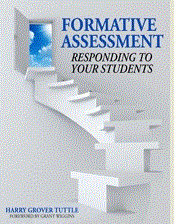Teachers understand that the grade in a course consists of many different factors such as homework, participation , projects, tests, etc. Blodget observes that sometimes grades reflect attitude, effort, ability and behavior (http://www.academia.edu/9074119/Grading_and_Whether_or_not_Grades_Accurately_Reflect_Student_Achievement). Equally important, a letter grade does not mean the same thing among grade level teachers. Does an “A” in Mrs. Brown’s 7th grade English class in Roxo Middle School equal an “A” in Mr. Cooper’s 7th grade English class in the same school? (tuttle, https://eduwithtechn.wordpress.com/2007/02/09/classroom-grades-dont-reflect-student-learning/)
The final grade in a course or even a ten week grade probably does not reflect the actual academic learning.These grades may not reflect the academic standards (Common Core, standards or proficiencies) for that course.
Badges allow teachers to focus specifically on student standards or proficiencies. A writing teacher may want badges to represent the various phases in the writing process. For example, a teacher might award an “idea generation” badge that indicates that the students can use at least two different brainstorming techniques to generate ideas for their writing. An “organizer” badge reflects that the students can use a graphic organizer or chart to plan out their writing. A “topic sentence” badge indicates that the student can consistently (three body paragraphs in the same essay) use topic sentences that introduce the purpose of the paragraph. An “Introductory paragraph” badge will demonstrate that the student can successfully write an introductory paragraph for two essays. A “revision” badge can show that the students can improve their writing by revising their own writing based on their own analysis and incorporating the formative comments of teachers or peers.
These writing badges represent specific writing proficiencies. Most students in their writing career have probably just obtained a letter gade on their writing which does not identify their strengthens. They probably have not received an overall writing grade. Their teachers may not have indicated the students’ growth over time in writing. However, badges quickly identify the students’ writing proficiencies and to-be-developed proficiencies.
Do you use grades or badges to measure your students’ progress on the standards or proficiencies?
Three books of interest:
Successful Student Writing Through Formative Assessment
English Common Core Mobile Activities ebook
Formative Assessment: Responding to your Students










How valuable is Peer Review?
Published December 15, 2008 Change , Comment , Composition , Edublogger , Education , ELA , English , Feedback , peer , Peer Review , Review , Revision , write , Writing Leave a CommentTags: Change, Comments, Composition, edublooger, Education, English, Essay, Feedback, Improve, peer, Peer Review, Revision, write, Writing
When my students hand in their final English essay, they also hand in their peer reviewed draft. I’ve noticed that usually they do not incorporate the changes that peers suggest.
I gave them a survey on peer review to help me better understand their use of peer’s comments. They admitted that they use very little of peer review.
Some of their reasons:
The reviewer isn’t as smart as I am.
I don’t care what they “feel” about my paper. What is good/bad according to the rubric?
They don’t understand the rubric.
It does not help me when a reviewer finds a mistake if he cannot tell me how to fix it.
They don’t understand my thinking/how I wrote the paper.
The reviewer found some spelling mistakes but missed the big things like my first body paragraph having two topics.
They don’t try/ they do not take it seriously.
How well do your students peer review each other? How valuable is the peer review to the author?
For any one who is interested in implementing formative assessment in the classroom, my book,
Formative Assessment: Responding to Students is available through Eye-on-Education.